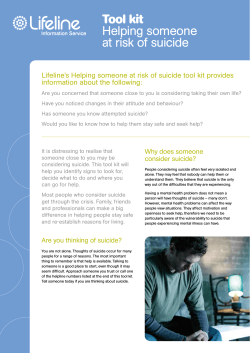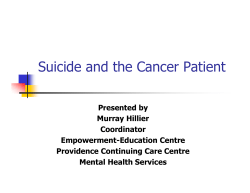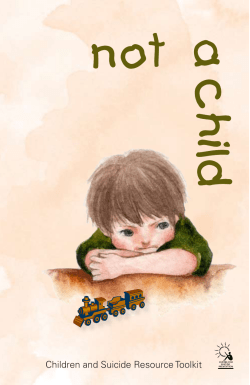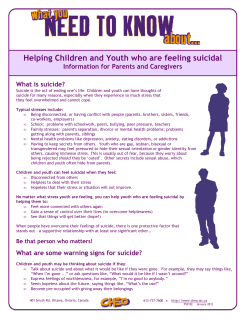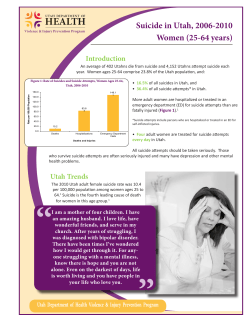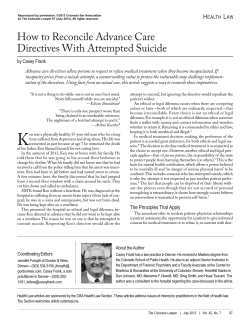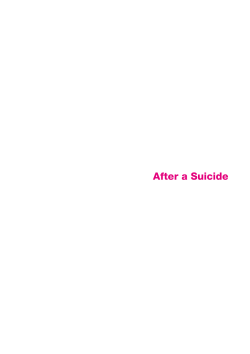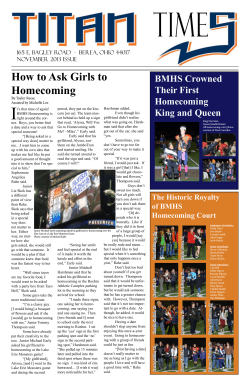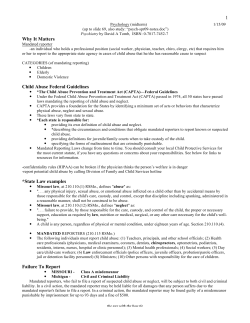
How to become involved Our mission
We Are LivingWorks1 We are the suicide intervention training company. We believe suicide can be prevented and communities made suicide-safer. We have been leaders in this field for over twenty-five years. We design, develop and deliver programs of the highest quality. We have programs for everyone who wants to help. LivingWorks programs help caregivers save lives. We bring hope to helpers. Our standardized programs can be tailored to your community. We train local trainers to conduct the programs. You can count on us for continuing support. Our Core Beliefs about Suicide and Its Prevention1 How to become involved We have resources you will value—you can apply them with people you care for. We invite anyone who shares our vision for suicidesafer communities to attend a training or an awareness session. We encourage those willing and able to invest in suicide safety to support our work. There are many ways you or your organization can become involved. Suicide can be prevented. It is possible to save lives and prevent injuries—now. Help-seeking is encouraged by open, direct and honest talk about suicide. If you are approachable, people at risk will seek you out. Imagine… a suicide-safer community. Support our work Benefit from our programs • Become a participant yourself • Send someone from your organization • Invite a LivingWorks trainer to train people in your organization, team or club Suicide is a community health problem. Everyone can help. Thoughts of suicide are understandable, complex and personal. Approach people at risk with an open mind. Our mission Apply to become a trainer • Attend a Training for Trainers (T4T) course • Develop the capacity of your organization to provide suicide alertness and intervention training • Become a donor, sponsor or funder • Help promote our work or support a project • Build an enterprise partnership. Invest in suicide safety through our work We aim to increase the capacity of people to provide suicide alertness and intervention training within their communities and organizations. Trained caregivers are then better prepared to respond to persons at risk. Contact us or visit www.livingworks.net for more information about suicide-safer communities. Relationships are the context of suicide intervention. Helping either relies upon or builds a relationship. Intervention should be the main suicide prevention focus. The emphasis should be on preventing suicidal behaviors. Cooperation is the essence of intervention. The helper and person at risk need to work together to prevent suicide. Intervention skills are known and can be learned. Helpful skills are known and most everyone can learn them. Large numbers of people can be taught intervention skills. The means to teach intervention skills on a large scale exist now. LivingWorks Education Inc. 4303D 11 St SE ∙ Calgary, AB, Canada T2G 4X1 TEL 403.209.0242 FAX 403.209.0259 TOLL FREE N.A. 1.888.733.5484 EMAIL info@livingworks.net LivingWorks Education LP PO Box 9607 ∙ Fayetteville, NC, USA 28311 TEL 910.867.8822 FAX 910.867.8832 TOLL FREE N.A. 1.888.733.5484 EMAIL usa@livingworks.net Partners in suicide prevention: We help people prevent suicide and communities become suicide-safer. LivingWorks programs were developed in response to a community concern about suicide. In our trainings, people learn how to help persons at risk keep safe and access further supports. The benefits live on. Why it matters Every year more people die by suicide than from all of the armed conflicts around the world and, in many places, about the same or more than those dying in motor vehicles. For every suicide, up to 100 others may be injured by non-fatal suicidal behaviors. In any year, as many as 6% of the population have serious thoughts of suicide. We know that most people considering suicide would choose to live if they had support to deal with painful problems in living. We also know that most people considering suicide communicate their intent, directly or indirectly. Our programs provide caregivers and other helpers with awareness and skills that help to save lives. Evidence of effectiveness should be broadly defined. These means are effective. www.livingworks.net Summary only; see www.livingworks.net 1 www.suicideinfo.ca www.chooselife.net www.suicidepreventionlifeline.org www.livingworks.org.nz LivingWorks programs are part of national, regional and organizational suicide prevention strategies around the world. The learning experiences are interactive, practical, regularly updated and customizable. Comprehensive, layered and integrated, there is a program for everyone who wants to help. What we offer Participants in LivingWorks programs: • increase their awareness of suicide and see prevention opportunities they may otherwise miss, dismiss or avoid • become more alert to invitations to ask someone if they are thinking about suicide • ask directly about suicide and then respond in ways that show understanding • work with persons at risk to assess risk and increase their safety • access further support from family, friends and professional helpers as needed • help family, friends, colleagues and team mates, in professional or volunteer roles www.unn.no/vivat © 07/2011 LivingWorks Education Inc. TOLL FREE N.A. 1.888.733.5484 info@livingworks.net www.livingworks.net LivingWorks: MID-1970S: The history of LivingWorks begins with volunteer work with the Canadian Mental Health Association (Calgary South Region). A multidisciplinary team develops the basics of the original “foundation workshop” in suicide first aid. It is developed as a foundation learning experience, modeled on CPR training for cardiac emergencies, upon which other programs can add to or extend. It is framed as a technology transfer activity that emerged from literature reviews and clinical experience pointing to a lack of adequate suicide intervention gatekeeper training among both community helpers and clinical professionals. EARLY 1980s: The workshop evolved out of an Alberta-wide suicide prevention plan. A Training for Trainers (T4T) model is trialed as the most efficient large scale dissemination technology to support low cost program delivery by local trainers. 1985: RTTL and CMHA reach a copyright and program delivery agreement. RTTL is granted copyright to the newly named Suicide Intervention Workshop (SIW) for mixed group training of community and professional caregivers/gatekeepers. The rights to disseminate the program within Alberta are given in perpetuity to CMHA (Alberta Division). RTTL has world rights to develop and disseminate the program outside of Alberta. RTTL adopts Rothman’s technology transfer method (social R&D) to convert core knowledge from suicidology into a standardized and contextually flexible suicide intervention program. Using Rothman’s design, develop and dissemination phases, the suicide first aid training program is implemented as widely as possible with high quality control standards. SIW training spreads beyond Alberta to various organizations in Canada, USA and then internationally. A brief history 1989: The US Army (V Corps) invites LivingWorks to deliver Applied Suicide Intervention Skills Training (ASIST), formerly SIW, to the European Command in Germany as part of the Army’s “Fit to Win” health program. 1989: Other learning experiences and training programs begin to be developed and integrated with the basic foundation platform of ASIST. All are designed to further the development of suicide-safer communities: Youth Suicide Awareness Program (1989), suicideCare (1991), WorkingTogether (1998), suicideTALK (2000) and safeTALK (2005). TODAY IN 2010: 1991: LivingWorks principals Ramsay and Tanney and CMHA’s Suicide Information and Education Centre (SIEC) are invited by the United Nations (UN) to organize, fundraise and host the world's first inter-regional experts meeting to develop a national strategy guideline. The UN guideline is drafted at Banff in 1993 and officially published in 1996. In 1994, a draft of the UN guideline motivates a suicide survivor to mobilize a nationwide grassroots suicide prevention advocacy movement in the US. Mobilizing a collaborative partnership between survivors, professionals, academics and corporations, the UN guideline underpins the formulation of the US' first comprehensive national suicide prevention strategy. This strategy, released in 2001, is the foundation for subsequent legislative policies and ongoing funding initiatives, administered by the Substance Abuse and Mental Health Services Administration (SAMHSA) of the Department of Human and Health Services (DHHS). 2003: The US Army initiates the first ever, in-theatre suicide intervention training in Iraq. Roger Tierney Richard Ramsay Bill Lang Bryan Tanney Tarie Kinzel Carole Thannhauser 1997: Roger Tierney, one of the founding partners, dies from cancer. 1997: Tarie Kinzel joins the LivingWorks team after 15 years of delivering LivingWorks training in Saskatchewan, and becomes a partner in the company in 2000. 1998: ASIST is introduced in Norway through a medical school initiative at the University of Northern Norway. All materials are translated and filmed in a Norwegian context. 2003: Scotland’s national suicide prevention strategy, Choose Life, imports ASIST. 2004: LivingWorks Education USA Inc. is formed. Jerry Swanner, former US Army Suicide Prevention Program Manager, is hired as Director. 2006: The National Suicide Prevention Line (NSPL) network with over 140 centers around the USA selects ASIST as their standard of practice training for crisis line workers. 2007: ASIST has spread to nationwide dissemi- Since Washington State launched a statewide suicide prevention program in 1995 that included ASIST, LivingWorks training has expanded to state or region wide application in more US states including: Alaska, Arizona, Colorado, Connecticut, Florida, Hawaii, Louisiana, Maryland, Michigan, Missouri, Montana, New Mexico, New York, North Carolina, Oklahoma, Oregon, Pennsylvania, South Dakota, Texas, Virginia and Wyoming. In Canada, LivingWorks programs are delivered from BC to Newfoundland and the northern territories including Yukon, Northwest Territories, Nunavut and Nunavuk. Government, non-government and corporate organizations engaged in health care, mental health, justice, public safety and community services are involved. LivingWorks ASIST, safeTALK and suicideTALK are integral to suicide prevention training throughout Scotland. Operations and CEO of LivingWorks. nation in Norway through “Vivat.” Vivat is embedded in Norway's national suicide prevention strategy and receives permanent funding status under the Department of Health. LivingWorks programs have become core components of national suicide prevention strategies in Wales (Project Safety) and the Republic of Ireland (Reach Out), are broadly disseminated through Health Trusts in Northern Ireland and are regionally delivered in England. 1999: Carole Thannhauser is hired as Director of 1980 1985 1990 1995 2000 2005 2010 1983: A core partnership engaged in develop- 1987: The California Department of Mental 1991: The US Army expands their invitation in Health (DMH) imported SIW, awarding RTTL their first single bid, out-of-state, out-of-country contract to serve all 58 counties in California. The original three-year contract is annually extended and funded until 1996, seven years beyond the original expiry date. Today, California trainers continue to deliver training across the state. Germany to include bereavement and grief training during the Desert Storm ground war. 1995: Washington State launches the second statewide suicide prevention program. ASIST is selected as the intervention training program for their gatekeeper training component. 2000: At the invitation of the US Army’s Chief of ment and delivery emerges out of the T4T trials. Three are from the original multidisciplinary team—Ramsay (Social Work); Tanney (Medicine), professional faculty academics at the University of Calgary (U of C); and Tierney, U of C Education Psychology doctorate and student counselor at Mount Royal College. The fourth is Lang, U of C Education Psychology doctorate and student counselor at the Banff School of Fine Arts. 2008: US Air Force Chaplains launch an initiative to deliver safeTALK, LivingWorks new suicide alertness training program. The Coast Guard and various Reserve and National Guard units deliver ASIST regularly across the country. US Navy units have been using ASIST since 1987. ASIST has significantly seeded in Singapore, New Zealand and Guam. Demonstrations and pockets of training have been introduced in Hong Kong, Korea, China, Fiji and India. Norway’s “Vivat” has seeded training initiatives in Russia, Lithuania, Denmark and Sweden. 1984: Correctional Services Canada (CSC) uses the foundation workshop nationwide for its frontline correctional officers. Ramsay, Tanney, Tierney and Lang (RTTL) organize as a partnership. 1987–88: RTTL receives a total of eight awards, including a Gold Medal at the New York Film Festival and an export development award from the Alberta Economic Development Department. RTTL’s training program video It Begins With You, produced by Communications Media at U of C, remains the most awarded film in U of C history. 1991: The RTTL partnership becomes LivingWorks Education Inc., a start-up company of U of C's new venture capital company, University Technologies International, Inc. (UTI). The core program is relabeled Applied Suicide Intervention Skills Training (ASIST). LivingWorks is UTI's first investment in soft-product development. An 11-year royalty agreement will expires in 2002 and UTI’s return on a non-repayable $50,000 loan to structure the company is close to 600%. 1995: Dissemination of LivingWorks programs to other military services in Canada, Australia, Norway, and the United Kingdom begins. 1995: A special agreement signed with Lifeline Australia receives Commonwealth funding for a three-year field trial. The program is adopted nationwide under the name LivingWorks Australia and administered under the auspices of Lifeline. 1997: LivingWorks receives another two export development awards—one from the U of C and one from the Calgary Economic Development Authority. Chaplains Office, LivingWorks joins the Menninger Leadership Centre of Topeka, Kansas to provide bi-annual suicide intervention training to Army Chaplains and Chaplain Assistants. US Air Force Chaplains launch a major training initiative to deliver ASIST. 2009: Army G-1 formally confirms ASIST as the 2001: LivingWorks becomes the primary provider of suicide intervention training for the US Army. 2002: LivingWorks receives the national Canadian Social Policy Knowledge Transfer award. suicide intervention training program for the US Army. 2009: ASIST is named one of Canada’s Culture of Peace Gifts to UNESCO in the International Decade of Peace. 2002–03: LivingWorks partners with US Army Materials Command and Applied Physics Laboratory, Johns Hopkins University to develop ASIST-R, a post-training reinforcement program. This is a pilot test of a virtual simulation skills retention program for the Department of Defense (DoD). 2007: Scotland’s National Training Award goes to Choose Life for the introduction and roll out of ASIST. ASIST is available in English and has been translated into French, Spanish, Norwegian and Inuktitut. safeTALK is available in English and has been translated into French. LivingWorks has increased its gross revenues more than 14-fold since 1995. The LivingWorks suite of programs is now the most widely used and the most recognized suicide prevention intervention training in the world. LivingWorks has over 5,000 community-based trainers around the world who train over 85,000 participants annually. Since 1985, close to one million caregivers have participated in ASIST.
© Copyright 2025

